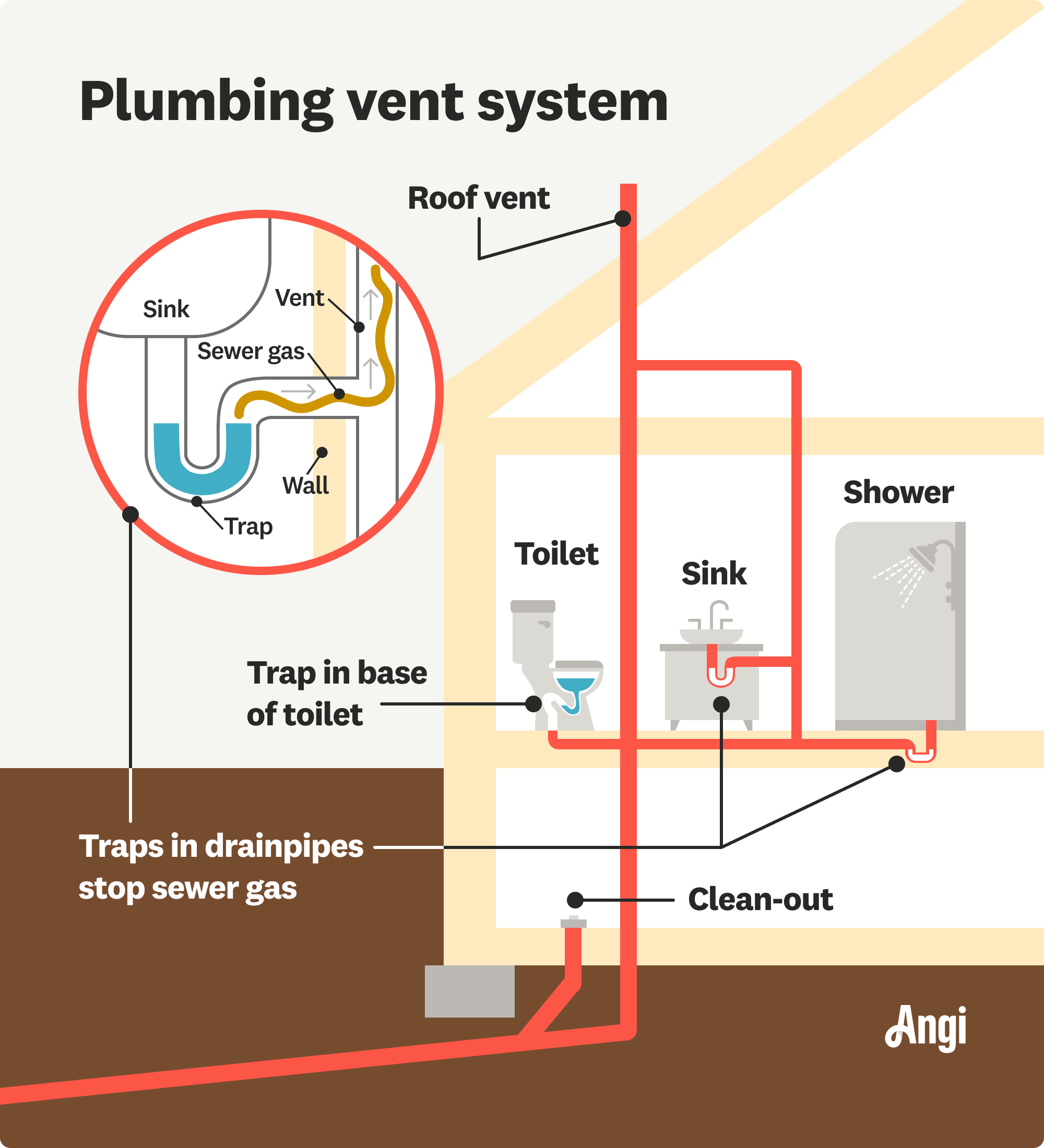
Learn about main water line repair costs in Phoenix and what affects your total to see how much you’ll need to budget for this major repair.
Learn how to clear a clogged vent without risking life and limb


You’ll need equipment like a hacksaw, auger, and heat tape to attempt to unclog a plumbing vent from your attic.
If you’re unsure about what you’re doing, cutting open a vent main stack can cause costly damage to your plumbing system.
Climbing on the roof with an auger or hose can be dangerous.
Getting a professional plumber to unclog a plumbing vent costs $150 to $200, which is a worthwhile investment to ensure the problem is fixed safely and correctly.
Drains that gurgle and take forever to empty, foul sewer odors in the house, and toilet tanks that mysteriously run dry all point to one culprit—a clogged plumbing vent. This integral part of your home’s plumbing system, known as a plumbing vent stack, is responsible for regulating airflow and keeping water flowing through drains while venting foul sewer smells. Though plumbing vents need little to no maintenance, they can become clogged with debris, leaves, and even curious wildlife. You can risk life and limb and climb on the roof to fix the problem, or you can follow one of these less risky methods to unclog a plumbing vent without getting on your roof.
Shaddai Plumbing team is great! They are very professional, they keep their word, they complete job without delays. Great quality. We had to replace old water pipes across 2-story home and their service was great. We asked to add additional water switches to be able to switch hot/cold water on and off in separate parts of home - and they did it. Now if it will be leak or other problem - we can switch off kitchen area, or second floor without impacting other parts of our home. Highly recommended!
It’s easy to misdiagnose a clogged vent as a clogged drain. Luckily, there are a number of ways to tell if it is indeed the plumbing vent without having to scale a ladder.
Slow drains: When debris is clogging the plumbing vent, it won’t allow air inside to help push water out of the drains. As a result, it will take longer for all the sinks and tubs to drain. A clogged plumbing vent is likely the culprit if you have multiple slow drains in your home.
Gurgling noises: If your toilet makes an odd gurgling noise when you flush it? Do the sink drains make a glugging noise as the sink empties? These sounds are signs that air can’t escape your plumbing system because the vent is clogged.
Sewer odors: A plumbing vent allows sewer smells to escape your home. When a vent is clogged, those gases can build up and eventually leak into living spaces. Sewer gases can be more than unpleasant. They can also be toxic, so don’t delay if you detect these sewer odors.
Understanding the parts of a plumbing system will help you spot warning signs and follow the steps below. The following diagram shows an example of what the system will look like.

While the only way to clear a clogged vent may be to climb on the roof, doing so is dangerous, especially if you need to haul equipment up with you. Before getting a ladder out, try these alternatives first.
All of the drains in your home lead to a large drain called the main stack. This large drainpipe not only carries wastewater to the curb and the city sewer or your septic system (if you’re not on city sewer), but it also functions as a vent for the plumbing system. The main stack extends from under your house up through each floor of the home, including the attic, before venting through the roof. You can access that vent pipe by heading to the attic.
Once you find the vent in the attic, cut a piece out of it using a hacksaw. You don’t need to make a large cut, as the hole only needs to be big enough to allow you to thread a plumbing auger into it. Insert the auger into the vent so it heads downward until you feel it push up against the clog. Crank the handle on the auger to chew the clog out. Once you’ve cleared the clog, you’ll need to repair the pipe using PVC coupling.
When clogged vents cause problems in the winter, snow and ice often collect over the roof vent opening, preventing proper airflow. Don’t attempt to climb on a snow-covered roof to clear the vent. A safer alternative is to melt the snow from the inside out.
There are several ways you can accomplish this:
Hot water: Running hot water creates steam and heat that rises through your vent pipe. Turn on a faucet on the uppermost floor of your home and allow it to run hot water for a while. The heat the water creates may be enough to melt any snow or ice that’s clogging the vent.
Hair dryer: Head to the attic with a hair dryer. Use it to direct warm air on the vent pipe as close to the attic ceiling as possible. The hair dryer will transfer enough heat to the pipe to melt the snow without causing damage to it or creating a fire hazard.
Heat tape: Despite its name, heat tape isn’t tape at all. It’s actually an electrical cable that creates a small amount of heat. While it’s mainly used to keep water supply lines from freezing in the wintertime, you can also wrap it around a plumbing vent pump in the attic to warm it and thaw any ice or snow that’s clogging it from the roof.
Though climbing on the roof is dangerous, it’s the most direct way to clear a clog and your only alternative if the above methods fail. Remember that climbing on the roof involves risk. If you have a roof with a steep slope or simply don’t feel comfortable doing it, the cost of hiring a licensed plumber to handle the job is worth it.
Hiring a pro who can get the job done right is worth avoiding costly DIY mistakes and the risk of injury. Plumbing repairs can add up so leave this one to an experienced plumber who can get your system back on track.
If you decide to attempt this repair yourself, take precautions by wearing footwear that will allow you to get good traction on the roof and have a helper on hand to assist you with the ladder.
You’ll need to bring a screwdriver in case the vent has a cap you need to pry off. Once up top, examine the vent to see if you can ascertain what’s causing the clog. It may be as simple as clearing debris or a bird's nest. If the clog isn’t visible and easily accessible, you’ll need to resort to other methods.
Water: Bring a garden hose with an adjustable nozzle onto the roof. Set the nozzle to a narrow high-pressure spray. Direct the spray down into the vent to clear away any clogs. If the water backs up and comes out of the pipe, you’ll need to take more drastic measures to clear the clog.
Plumber’s snake: Bring a plumbing snake or auger onto the roof. Run it down the vent until you reach the obstruction. Turn the crank on the plumbing auger to cut through and remove the clog.
The best way to deal with a clogged plumbing vent pipe is to prevent it from getting clogged in the first place.
Screen: Install a screen or filter over the top of the vent pipe to prevent debris from falling in the vent or animals from crawling inside.
Pipe insulation: Wrapping the pipe in foam insulation can help it retain heat, preventing snow and ice from forming on top of it.
While clearing a clogged plumbing vent isn’t complicated, it can be potentially dangerous depending on the lengths you must take to fix the problem. The best approach when dealing with this issue is to try easy fixes first by attempting to clear the clog from the attic. If this fails, determine how risky it is to attempt to move the clog from the roof yourself.
Consider the pitch of the roof, how high it is off the ground, and how difficult it will be to haul equipment such as a garden hose or plumbing auger up to the vent. If the job is too dangerous, hire a pro to take care of it.
If you decide to hire a licensed plumber near you to handle the fix, you can expect to pay between $150 and $200 for this service, although it could cost more depending on the severity of the problem.
From average costs to expert advice, get all the answers you need to get your job done.

Learn about main water line repair costs in Phoenix and what affects your total to see how much you’ll need to budget for this major repair.

Learn about how much main water line replacement costs in Phoenix. Desert conditions, caliche soil, and local regulations will all affect your total expenses.

Discover the cost to hire a plumber in Phoenix, including small fixes and major projects, and learn how heat, soil, and permits impact final prices.

Understand how much water a toilet uses per flush and find ways to make your house more sustainable and efficient while lowering water bills.

Discover grey water system cost details to learn about installation, maintenance, and ways to save on your home’s grey water system.

Severe winter weather causes well water pipes to freeze, obstructing water flow and leading to pipe bursts. Here’s what to do if your well water is frozen.